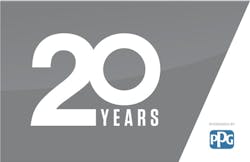Nick Notte’s father was an engineer who challenged him to look at the world in different ways. With his innovative spirit, Notte restored his first car at the age 14 and did a fair amount of painting and metal restoration in his younger years. After graduating high school he moved on to get an accounting degree, but he carried his love for cars throughout his life.
Notte has held many different positions throughout his career. He’s served in notable positions at Allstate, the National Auto Body Council (NABC), Mitchell International, Nobilas North America (AkzoNobel), I-CAR and Sterling Autobody Centers. Now the senior vice president of sales and marketing at I-CAR, Notte is an industry leader who continues to inspire and support those in the collision repair industry.
How does the industry today compare to what it was like 20 years ago?
A while back, we hosted I-CAR’s Volunteer and Instructor Conference with the theme of, “One industry, one goal.” This really resonated with me, and I think that goal has developed over the past 20 years into repairing cars right and really just doing the right thing.
The industry has many more relationships within it now than it used to. There’s now insurers working with repairers, both of these sides work directly with suppliers, and manufacturers are working with the industry in a new way.
Because of this, repairing vehicles safely and making sure customers are in good hands has been a shift in focus for most shops. Things like cycle time, reducing waste and new manufacturing principles have also come into play, but going back to the idea of having “one goal,” I think the safety and quality aspect of collision repair is huge. It’s not that this wasn’t important in the past, but with all of the ADAS technology in vehicles today, there’s a much bigger focus on it.
All of a sudden there’s a lot more training in the industry. What was once two-thirds of the industry not training, has been reduced down to about 58 percent. I think this training combined with new certification requirements coming from car manufacturers has lead to better quality repairs in comparison to the work done 20 years ago.
What has been the biggest game changer over the past 20 years?
One game changer is the amount of money coming into our industry. With private equity firms and venture capitalists coming into play, they have done work to reduce margins and there’s been a huge cash flow in collision repair.
Twenty years ago, the industry was still pretty segmented. Then concepts like standard operating procedures came into the picture to increase efficiency and bring in more money to facilities.
The technician shortage remains an issue, but with more complicated vehicle construction these days, I see kids at a younger age wanting to get involved in the industry. Younger generations love the fact that cars are essentially rolling computers, and it seems that more parents are allowing their kids to work in the field or start at technical schools.
What do shops need to do to be successful over the next 20 years?
There are many things that a shop needs to do to stay successful. The first thing is that shops need to protect themselves. As vehicle complexity increases, many shops have needed to evaluate their capabilities and examine the areas in which they need to to invest. Technicians could be hurt just looking at and touching new, more complex cars if they don’t know what to do.
If technicians are not trained on how to fix cars right, they could complete the repair but hurt the consumer. Training is crucial. Training should be a major investment in the collision industry. Not just for collision repairers, but for insurers, suppliers, information providers, everyone. Everyone should know what’s in these vehicles and how to repair them.
Shops also need to show value to stakeholders. This means quality repairs for consumers, good relationships with insurers, and keeping up on certification requirements with manufacturers. Proving to stakeholders that your business is concerned with things like cycle time and touch time is important. Show your stakeholders, “Hey, I got this.”
It’s the reality that shops can’t operate without quality technicians. Not only attracting great talent, but also retaining those technicians is vital. I’ve seen some top tier employees leave because their manager didn’t invest in new ways of training them. People want to be developed, and that’s a big deal in the industry. It all comes down to continuing training.
